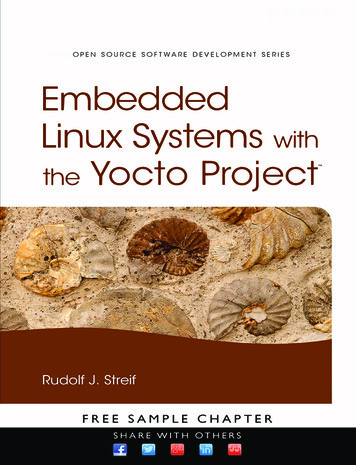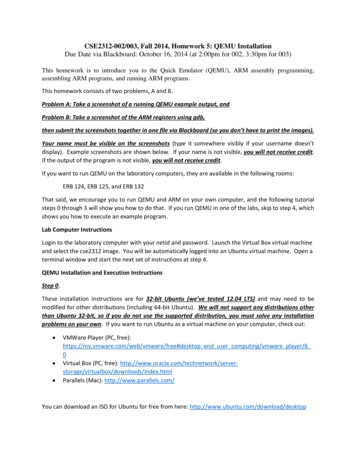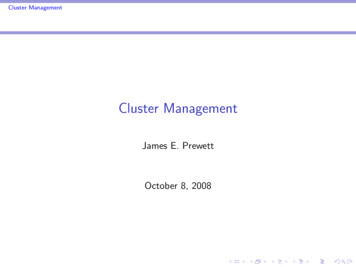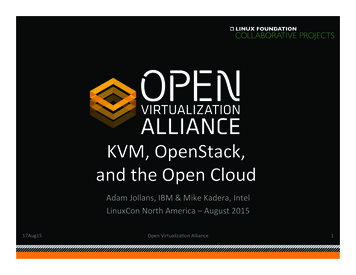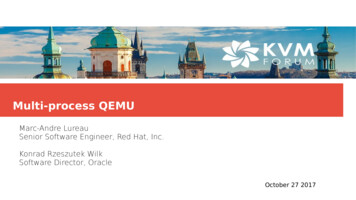
Transcription
Multi-process QEMUMarc-Andre LureauSenior Software Engineer, Red Hat, Inc.Konrad Rzeszutek WilkSoftware Director, OracleOctober 27 2017
Presented withSlim down QEMUKonrad Rzeszutek WilkSoftware Director, Oracle, Inc.Marc-Andre LureauSenior Software Engineer, Red Hat, Inc.Copyright 2017, Oracle and/or its affiliates. All rights reserved. 2
Program Agenda1QEMU in virtualization2Xen usage of QEMU3KVM usage of QEMU4Security!Copyright 2017, Oracle and/or its affiliates. All rights reserved. 3
QEMU usage Both KVM and Xen use QEMU emulation (IDE, e1000) None use the binary translation in QEMU.–Xen and KVM in the hypervisor code base deal with opcodes:– movdqa m128,xmm– (traped on MMIO access) KVM uses QEMU as control stack (launch/destroy guest) as in privilegedoperations (access to /dev/kvm). Xen uses only QEMU emulation (which is why you can’t launch guestswith QEMU parameters and need to use libvirt or xl).Copyright 2017, Oracle and/or its affiliates. All rights reserved. 4
Evil guest attack vectors Cloud provides have to deal with risk of customers becoming evil. The “customers” have usually four primary attack vectors:–Emulation (VENOM – CVE-2015-3456) of floppy driver, VGA, NICs, etc in QEMU.–MSRs (x2APIC range gap – CVE-2014-7188) of x2APIC emulation in hypervisor.–VMCALL (hypercalls to hypervisor – CVE-2012-3497).–Opcode emulations (INVEPT instructions – CVE-2015-0418). This talk is about the first: QEMU and ways to lessen the impact if it isexploited, or alternatively erect more “jails” around QEMU.Copyright 2017, Oracle and/or its affiliates. All rights reserved. 5
Xen and KVM architecture (usual)6Copyright 2017, Oracle and/or its affiliates. All rights reserved.
Xen disaggregated architecture Move QEMU to be a standaloneguest running in ring0 (32MBguest).Each stubdomain serves oneguest.Evil guest has to subvert stubdomain emulation first, then fromthere jump to control domain.Copyright 2017, Oracle and/or its affiliates. All rights reserved.
Xen disaggregated architecture (network) Evil guest uses e1000 for attack.QEMU uses PV frontend driver to sendpackets to real backendIf evil guest subverts stub domain thenext attack is the PV protocolCVE-2015-8550: double fetch:“Specifically the shared memory between thefrontend and backend can be fetched twice(during which time the frontend can alter thecontents) possibly leading to arbitrary codeexecution in backend. But protocol MUCH simplerthan emulated devices.Copyright 2017, Oracle and/or its affiliates. All rights reserved.
Xen disaggregated architecture (serial) Privilege opcodes (out/in) alwaysend up in hypervisor.A ring between hypervisor andQEMU for device model toprocess.QEMU and xenstored have a PVring to copy data back/forth.Copyright 2017, Oracle and/or its affiliates. All rights reserved.
Xen disaggregated architecture: jail around QEMU In effect the barrier betweenQEMU and control stack is via thePV ring.If evil guest exploits stub domainthey are the same place asbefore.Attacks left then are via:––––MSRsHypervisor hypercallsOpcode emulation(But this presentation is not about thoseattacks).Copyright 2017, Oracle and/or its affiliates. All rights reserved.
Can we do something similar in KVM?Copyright 2017, Oracle and/or its affiliates. All rights reserved.
Can we do something similar in KVM? Is it needed? QEMU is used for emulation and control stack.–If we disaggregate QEMU we can move each component in its own process. We have security measures in place:–secomp & ebpf (filter the ioctls to /dev/kvm)–Containers (chroot jails)–Continuing work on improving QEMU security Sure, but separating components apart (each running in its own jail)means we can focus security audit on the high-stake parts OK, how do we do this?Copyright 2017, Oracle and/or its affiliates. All rights reserved. 12
Copyright 2017, Oracle and/or its affiliates. All rights reserved. 13
Multi-process QEMUMarc-Andre LureauSenior Software Engineer, Red Hat, Inc.Konrad Rzeszutek WilkSoftware Director, OracleOctober 27 2017
Motivations for QEMU Requirements for devices KVM features Various QEMU solutions Conclusion & QA
A big binaryelmarco@boraha: ls -lhS /bin/ head -n20-rwxr-xr-x.1 root root33M Aug 16 16:00 dockerd-current-rwxr-xr-x.1 root root17M Sep 15 00:46 emacs-25.3-rwxr-xr-x.1 root root16M Sep 7 16:32 node-rwxr-xr-x.1 root root15M Jun 26 11:51 ocamlopt.byte-rwxr-xr-x.1 root root15M Jul 4 15:33 doxygen-rwxr-xr-x.1 root root13M Aug 16 16:00 docker-current-rwxr-xr-x.1 root root12M Sep 8 21:59 qemu-system-aarch64-rwxr-xr-x.1 root root12M Sep 8 21:59 qemu-system-arm-rwxr-xr-x.1 root root12M Jun 26 11:51 ocaml-rwxr-xr-x.1 root root11M Sep 8 21:59 qemu-system-x86 64-rwxr-xr-x.1 root root11M Sep 8 21:59 qemu-system-i386-rwxr-xr-x.1 root root11M Jun 26 11:51 ocamlc.byte-rwxr-xr-x.1 root root11M Sep 8 21:59 qemu-system-mips64el-rwxr-xr-x.1 root root11M Sep 8 21:59 qemu-system-mips64-rwxr-xr-x.1 root root11M Sep 8 21:59 qemu-system-mipsel-rwxr-xr-x.1 root root-rwxr-xr-x.1 root root7.1M Apr 25 17:44 crash-rwxr-xr-x.1 root root6.9M Jun 26 11:51 ocamldoc.opt-rwxr-xr-x.1 root root6.4M Jun 26 11:51 ocamlopt.opt1811M Sep 8 21:59 qemu-system-mips
A big project -cloc qemu-2.10files: 4 280comment: 172 425code: 1 186 140 -cloc kvmtoolfiles: 275comment: 3 728code: 27 844cloc crosvmcode: 32 15919 cloc linux- files: 49 744- code: 16 834 046How much with all dependencies?
Still growing140000012000001000000800000Mostly in 2.62.72.82.92.10
Many dependencies Fedora 26: qemu 2.9.0-5.fc26.x86 64 readelf -d /usr/bin/qemu-system-x86 6460 grep NEEDED wc -l ldd /usr/bin/qemu-system-x86 64 wc -l158 Kvmtool (with all optional dependencies, gtk3, SDL, vncserver.) readelf -d lkvm grep NEEDED wc -l19 ldd lkvm wc -l8321
Too big to fail22
Paolo threads24
Ideal architecture tdUI
Why not? The monolithic vs microkernel/services debate Difficult to manage Difficult to debug Difficult to test (test matrix) Performance?
Why seperate processes? Modularity clear interface separation less conflicts/bql concerns smaller qemu, less dependencies allowing alternative implementations, “crazy” ideas separate projects, different release cycles. Isolation ( iommu) & crash robustness Better sandboxing (seccomp/ns) Easier monitoring/tweaking (memory, cpu etc)
Sandboxing for dummiesChange user idRegular DAC/MAC checkAdd/drop capabilites(7)Subset of root privileges (if needed)Namespaces(7)Own view/access of the system (uid/pid/ns/net/ipc.)Seccomp()/bpfFilter syscallsLibvirt, minijail, systemd, flatpack.
A word about memory fragmentationAll devices & workloads in a single process can lead to morefragmentation.Using subprocesses may help to partition the load and moreeasily reclaim the space.
How? various strategies Fork-only strategy (crosvm) Code in same binary No version combinations, less modularity Device setup and teardown can be hardcoded in parentExec a helper or device process Can allow arbitrary implementations IPC require greater level of stability Nicer if IPC allows various kind of devices30
Managing the processes Qemu Not a great idea to fork from qemu (VM space, safety) Slirp & migration can do it. Could exec() from an helper process instead?Outside, libvirt or other: Not suitable for command line users Natural fit for libvirt etc31
How? various device needs HW description & bus registration Communication mechanism: Io / Mmio regions & rw events, Irqs Memory map (& iommu) Or at higher level of abstraction (USB etc) acpi / device-tree manipulation (& fw cfg) Device state & migration Dirty regions tracking, post-copy. Object hierarchy / introspection32
KVM - device emulationDirect memory accessOr VM exit:run mmap(cpufd,.)ioctl(cpufd, KVM RUN)run exit reason KVM EXIT IO/MMIOrun io/mmio addr mappingBQL!MemoryRegionOps.read/write() ioctl(vmfd, KVM IRQ LINE, irq level)33
KVM nifty ioctlKVM IOEVENTFDThis ioctl attaches or detaches an ioeventfd to a legal pio/mmio address within the guest. Aguest write in the registered address will signal the provided event instead of triggering anexit.KVM IRQFDAllows setting an eventfd to directly trigger a guest interrupt.34
Ioeventfd vs MemoryRegionOpsstruct kvm ioeventfd {u64 datamatch;u64 addr;u32 len;s32 fd;u32 flags;u8 pad[36];};/* legal pio/mmio address *//* 0, 1, 2, 4, or 8 bytes*/Write only, coalesced events, not a range APIExtend it to support ranges - IOEVENTFD FLAG RANGE?Then KVM GET IOEVENTS (similarity with AIO)35
For traditional sync devicesIPC qemu helper (necessary for TCG)Introduce a KVM user device?devfd ioctl(vmfd, KVM CREATE DEVICE USER)reg {.group KVM DEV USER GROUP,.attr KVM DEV USER SET MEMORY REGION,.addr (struct) { .slot 0,.addr 0x3f8,.flags PIO,.eventfd efd }}ioctl(devfd, KVM SET DEVICE ATTR, ®)poll(efd)ioctl(devfd, KVM GET DEVICE CPU EXITS, &exits)ioctl(devfd, KVM SET DEVICE CPU EXITS, &exits)36
MigrationIn qemu stream vs out of streamHandled by qemu or notSecurity aspectShare VMState infrastructure with helper?Instead of blobsMake it a library, IPC hook for saving/loading to/from streamUnlikely to be accepted as standard in external projectsMostly non-existent today, with rare exceptions37
And today? VNC / Spice Block devices usbredir / cacard ipmi-bmc-extern TPM emulation ivshmem device vhost, vhost-user VFIO/mdev38
VNC & SpiceUI in remote processResume sessionMigrationVT & monitor?39
What about?QEMU to start a graphical client instead?Remove GTK/SDL/VTE/audio code from qemu?40
Block devices qemu-nbd -k nbd.sock vm.qcow2 qemu -drive driver nbd,server.path nbd.sock,server.type unixQemuprocessNBD serverprocess(other protocols exist: iSCSI, NBD, SSH, Sheepdog, gluster, http/ftp.)41
Block devicesWould performance be good enough for general case?Could use shared memory, to avoid extra copy, opportunistic polling.42
Usbredir usbredirserver -p 2001 vendorid : prodid qemu ehci-uhci -chardev socket,port 2001,id chr-device usb-redir,chardev chrQemuprocess migrate43USB deviceprocess migrate
USB DevicesQEMU emulation of USB devices instandalone process using usbredir API?44
Cacard qemu -device usb-ccid-chardev socket,server,port 2001,id chr-device ccid-card-passthru,chardev chr vscclient host 2001Qemuprocess migrate45Smartcardprocess migrate
Ipmi-bmc-extern ipmilan -c conf-file -f cmd-file -s statedir qemu -device ipmi-bmc-extern,chardev chr-chardev socket,id chr,host localhost,port -device isa-ipmi-bt,bmc bmc0,irq 0Qemuprocess46Ipmi/BMCprocess
TPM emulator swtpm socket --tpmstate dir /tmp/myvtpm --ctrltype unixio,path /tmp/ctrl qemu -tpmdev emulator,id tpm0,chardev chr-chardev socket,id chr,path /tmp/ctrl-device tpm-tis,tpmdev tpm-tpm0,id tpm0QemuprocessTPM deviceprocess migrate soon47
Vhost overviewHost OSQEMUGuest OS48Virtiovirtio-netdevvhostLinux:- net- vsock- scsi
QEMUvhost-userGuest OSvhost-uservirtio-netvirtioVirtio devevents: kick/call-net, -scsi today!-blk, -gpu, -input, -crypto coming!49vhost-user
Vhost(-user) in a nutshellMemory listener to have RAM flat viewSET MEM TABLE(Fd)34.SET VRING ADDR,SET VRING NUMGuestAddress0xA000Index DescAddress00xf2bc1000SET VRING KICK(fd), SET VRING CALL(fd)50UserSizeAddress0xf2bc0000 000
vhost-user-gpu gpu stack outQEMUBetter perfBetter securityGuest OSGPU Virtio dev-object vhost-user-backend,id vug,cmd "./vhost-user-gpu"-device virtio-vga,virgl true,vhost-user vugGPU socket commands:- SCANOUT- UPDATE- GL SCANOUT- GL UPDATE ( )- CURSOR UPDATE51Could be handled outside of QEMU(spice or client)
Benefits of virgl out of process?- avoids blocking qemu main loopShaders may take long to compile- virgl needs to do polling (GL queries & fences)- virgl crash (various crash/leaks fixed)- GL isn’t a very safe API (size/buffer mismatch – ARB robustnessis an extension)52
Mdev / vfio overviewQEMUGuest OSvirtio-netHost OSvfio-pci53vfio / mdevCan be mediated to hardwareOr just software (mtty sample)
VFIO in userspace?Implement PCI devices in userspace with a VFIO-user?54
Conclusion Qemu is mostly monolithic & big todayStrategies to run separate processes exist, but providedifferent interfaces & integration levels Use vhost-user for virtio devices Many ideas for a multi-process future55
Questions56
STOP STOP STOP STOP STOP STOP STOPSTOPSTOP migrate migrate57
Virtio device vhost-user deviceCheck ioeventfd supportvhost dev.vqs g new(vhost queues, N)vhost dev init(vhost, chr, TYPE USER, timeout)VirtioDeviceClass.set status() & reset():vhost dev enable notifiers()VirtioBus parent: set guest notifiers()Set dev.acked features virtio.guest featuresvhost dev start()vhost virtqueue mask() forall queues58
59Guest Vhost-pci WIP(Inter-VM communication)Guest OSvirtio-netvhost-pci-net
QEMU MasterHeterogeneous QEMUVCPU XIDMMasterMemorySlaveMemoryQEMU SlaveVCPU YIDMIDM protocol“[RFC PATCH 0/8] Towards an Heterogeneous QEMU” C. Pinto Sept 2015& virtio-sdm & also xilinx remote-proc60
1 root root 11M Sep 8 21:59 qemu-system-mips-rwxr-xr-x. 1 root root 7.1M Apr 25 17:44 crash-rwxr-xr-x. 1 root root 6.9M Jun 26 11:51 ocamldoc.opt . Sandboxing for dummies Change user id Regular DAC/MAC check Add/drop capabilites(7) Subset of root privileges (if needed) Namespaces(7)




